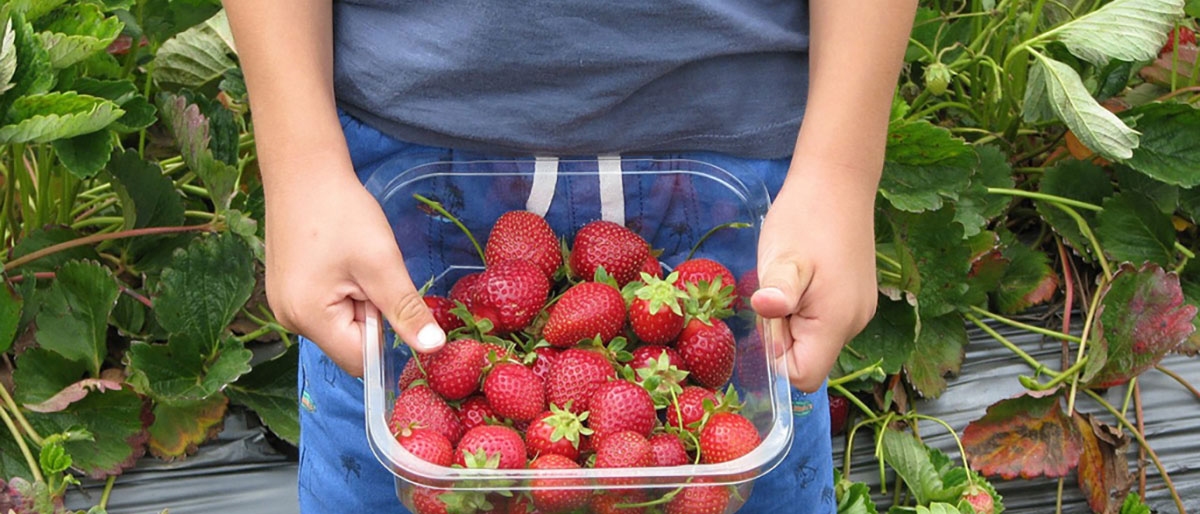- be_ixf; php_sdk; php_sdk_1.4.18
- 28 ms
- iy_2025; im_11; id_30; ih_12; imh_22; i_epoch:1.76453414746E+12
- ixf-compiler; ixf-compiler_1.0.0.0
- py_2025; pm_10; pd_08; ph_06; pmh_56; p_epoch:1.75993178248E+12
- link-block; link-block_link-block; bodystr
- pn_tstr:Wed Oct 08 06:56:22 PST 2025; pn_epoch:1.75993178248E+12
- 0 ms
- be_ixf; php_sdk; php_sdk_1.4.18
- https://sou.edu/academics/from-sous-hon-319-the-reality-of-strawberries-from-mexico/
- https://sou.edu/academics/from-sous-hon-319-the-reality-of-strawberries-from-mexico/

The Reality of Strawberries from Mexico
From SOU’s HON 319
Imagine: Late last night you and your son arrived in Los Reyes, Michoacán, Mexico – Mexico’s top strawberry producer. You stayed with your cousin who lives in Los Reyes. He let you sleep in the living room, tomorrow you’ll have to find somewhere else to stay. You pretended to sleep so your son could do the same. Now it’s four in the morning, and time to go to work. Your cousin says there is work on a farm outside of town. Strawberries. You’ll pick for 10 hours with no break, for 11 pesos an hour. Your son, who is only 14, isn’t legally old enough to work on a farm, but as long as you don’t say anything, they won’t ask any questions. Together, you’ll make 220 pesos for the day. That’s $12.66 USD. That will be just enough to pay for a night in a cramped room, some rice and beans for dinner, and a little bit of money to send home to your family. Then tomorrow you’ll start it all over again. This is the life of the Mexican workers that picked your strawberries. This is the life of so many farmers in Mexico. How does that make you feel?
In Southern Oregon University’s class HON 319: Nature, Culture, Mexico, we dived into research articles about water quality, access to water, and the effects of agricultural practices on water availability throughout Mexico. In one such text, “Water Flowing North of the Border,” author Christian Zlolinski explores how agricultural production has led to the scarcity of water for Baja California locals. According to his findings, high quantities of water are exported to the United States and Canada inside fresh produce (Zloniski, 2011). This offers the convenience of fresh fruit and produce to other countries in exchange for water insecurity in rural Mexico. These communities have very little access to fresh, clean water because it is preferentially diverted to agricultural production. The Mexican government is influenced by big farming corporations to give institutionalized farmers better access to fresh water and restrict access for smaller, local growers, and domestic consumers (Zlolniski, 2011).
In addition to deliberately restricted water access, locals in Baja California encounter further difficulties as they face environmental degradation caused by the overconsumption of water by agribusinesses. Baja California is an arid region with around 7.8 inches (200 mm) of annual rainfall. Due to the low rainfall, there isn’t enough water to recharge depleting aquifers. Out of the 48 aquifers identified in the state of Baja California, 15 no longer have any available water and many others are so depleted that only brackish water can be extracted from them (Cortés-Ruiz et al., 2020; Daesslé et al., 2008). This makes water more expensive to clean, leading to increases in the cost of tap water. This overexploitation has caused a drop in the water table, causing desertification in the region as flora disappears from the landscape. Efforts to re-stabilize the water table have been made in order to bring back water security to the region. However, funding is limited and estimates have shown that it would cost $82 million USD in addition to much of the state’s cropland for Baja California’s water scarcity issues to be solved (Cortés-Ruiz et al., 2020).
Strawberries seem to be the source of a lot of grief for many Mexican citizens, and it’s also not doing any favors for the environment. So why is this still such a serious problem despite the obvious issues for it? Mexico makes up 14.83% of the entire world’s strawberry production, with 35% of Mexico’s strawberries being grown in Baja California. Because Mexico makes up more than 10% of the global strawberry production, it is a certifiably successful industry (Cossio & Flores, 2021; Wu et al., 2018). Mexico’s GDP and economy look incredible on paper because of the money they make off of export agriculture, specifically water-heavy horticulture (Cossio & Flores, 2021). Thanks to this extreme success, this business model makes the country lots of money and provides jobs for the rural population. The clear catch, however, is the sheer amount of water that goes into these crops. An estimated 76% of all water extracted goes to agriculture (Beta Aqueduct). Meanwhile, workers reap close to zero worthwhile benefits and have difficulty accessing clean water. Most of the wages earned from working in agriculture go into paying for basic human needs, the most outrageous being water. In some cases, locals may spend up to two-thirds of their monthly wages on potable water (Zloniski, 2011). So agribusiness in Mexico is a booming industry that supplies many people with jobs that pay livable wages. But those livable wages are just that. Livable. A citizen living in the rural areas of Mexico will spend most of their working life just making enough money to put food on the table until the next paycheck. The real benefits of the Mexican agricultural economy are really only visible in urban areas, such as Mexico City, and various tourist destinations around the country.
So far you have seen abysmal living conditions of Mexican farmers, caused by the agricultural practices in Mexico. The impacts this has had on farmers and the environment are atrocious. Once beautiful, lush landscapes are now dry and desolate because of the water shortage, and produce for export is given preferential access to water over people who lack fresh running water. All of this is possible because there is a market for cheap produce year-round. If there isn’t a market for it, then strawberries and other crops that are grown out of your local season will stop being produced. To make that a reality, consumers need to make the change. Instead of buying strawberries, tomatoes, and cucumbers from Mexico, buy them locally. Supermarket packaging doesn’t always say where produce is coming from, but farmers’ markets are always local. Not only are you not contributing to water shortages in rural Mexico, but you’re supporting local farmers and lowering fossil fuel usage in transporting crops. To top it off, locally sourced, organic produce tastes better and is better for you. As the summer continues and produce comes into season, spend your weekends wandering the aisles of a farmers’ market instead of a supermarket. Your local farmers will thank you.
Authors: Liam Jones, Sierra Garrett, Caleb Zinn, Dylan Hurlimann
Sources:
Beta Aqueduct. “Aqueduct Country Ranking.” n.d. https://www.wri.org/applications/aqueduct/country-rankings/?country=MEX&indicator=bws. Accessed: 06/12/2023
Cortés-Ruiz, A., & Azuz-Adeath, I. (2020). Estimating the future hydric needs of Baja California, Mexico. assessment of scenarios to stop being a region with water scarcity. Water Supply, 21(6), 2760–2771. https://doi.org/10.2166/ws.2020.198
Cossio, A. J. A., Flores, A. A. H. (2021, March 15). Competitividad de la Fresa mexicana en el Mercado Estadounidense de 1992 a 2017. Ciencia y Tecnología Agropecuaria. https://revistacta.agrosavia.co/index.php/revista/article/view/1414
Daesslé, L. W., Ruiz-Montoya, L., Tobschall, H. J., Chandrajith, R., Camacho-Ibar, V. F., Mendoza-Espinosa, L. G., Quintanilla-Montoya, A. L., & Lugo-Ibarra, K. C. (2008). Fluoride, nitrate and water hardness in groundwater supplied to the rural communities of Ensenada County, Baja California, Mexico. Environmental Geology, 58(2), 419–429. https://doi.org/10.1007/s00254-008-1512-9
Wu, F., Guan, Z., Garcia-Nazareiga, M., & Arana-Coronado, J. (2018). An overview of Strawberry Production in Mexico. University of Florida. https://edis.ifas.ufl.edu/publication/FE1014
Zlolniski, C. (2011). Water flowing north of the border: Export Agriculture and Water Politics in a rural community in Baja California. Cultural Anthropology, 26(4), 565–588. https://doi.org/10.1111/j.1548-1360.2011.01112.x


